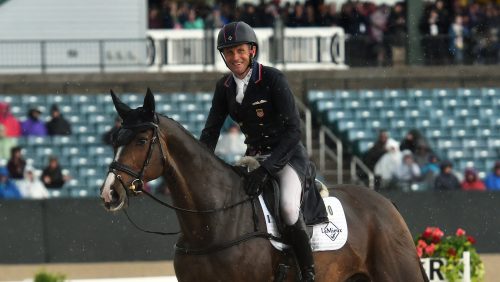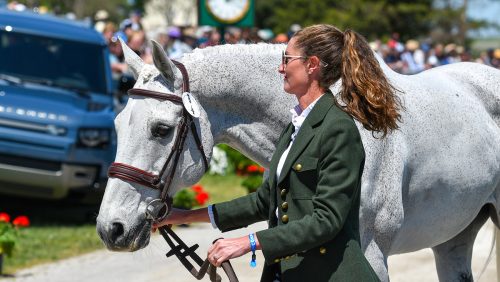Blood on the flanks, mandatory rest hours, and flag and frangible pin penalties were among the rules up for discussion at the Fédération Equestre Internationale’s Sports Forum, held March 30-April 1 in Lausanne, Switzerland. (Read our coverage of the first day of the forum here.) The forum served as the jumping-off point for the quadrennial process of full rules revisions for the sports of jumping, eventing, driving and para-driving.
The sessions were intended to introduce areas for discussion and possible rule changes, based on suggestions from national federations. Full details of any proposed rule changes are still to be worked out over the course of the next few months. Final rule changes are voted on at the FEI General Assembly in November.
Jumping Rule Changes
The panel discussion for jumping rule changes, moderated by Jessica Kürten, chair of the FEI Athletes Committee, took place on the first day of the forum and included discussion of reducing the penalty for instances of minor blood on the flanks, more strictly enforcing mandatory rest hours during competitions, and introducing minimum eligibility requirements to compete at the three-star level or higher.

FEI Jumping Director Todd Hinde began the session by noting that a main goal of the process is to restructure and simplify the rulebook, and to assist with that, sports attorney Lauren Pagé of London-based international law firm Bird & Bird has been brought in. Pagé, who is an equestrian herself, has extensive experience with rules revision and was part of the full rule revision for endurance in 2023, Hinde said.
“When we discussed this, we wanted to make sure that we created a simplified rulebook that was easy to understand and to navigate,” he explained. “However when I say simplified, that’s not taking away from the spirit of the rules or weakening the rules.”
The first rule discussed was Article 241.3, which covers situations where a horse is found to have blood on its flanks. Panelist Cesar Hirsch, president of the Pan American Equestrian Confederation and a level 4 FEI judge and steward, noted that the rule has served its purpose and raised awareness, and the number of cases has decreased since it went into effect. “For me, it’s not just about the rule, it’s about the approach and the direction that we’re all going to take of the direction of the sport,” he said. “The sport evolves and the rule needs to evolve too.”
He emphasized officials’ need for clarity and transparency, so the rule can be enforced fairly, and that it should be applied equally across all levels.
FEI Jumping Committee Chair Stephan Ellenbruch clarified that this rule applies when a horse comes out of the ring and has some blood from a minor scratch, such as from a rider’s spur, which would be cause for elimination. A different rule applies if a horse shows up at a competition with marks indicating prior excessive use of the spurs or whip, which is a mandatory disqualification from competition; that rule was not up for discussion at the forum.
He also provided some context on the frequency of these minor cases of bleeding after a round.
“Ten years ago, we had lots of blood cases,” he said. Prohibiting rowel spurs reduced those cases significantly, he said, and today the vast majority of instances—Ellenbruch estimated 90 to 95 percent—are caused by hammer spurs, which have square ends.
Participants all agreed that the rule was necessary, but that it might be time to consider some modifications to the consequences, such as receiving a warning or a yellow card for a first infraction.

International Jumping Riders Club President François Mathy Jr. spoke of needing more proportionality between the violation and the sanction.
“Of course we need this rule, because [neither] the riders nor the officials or the public want to see a horse with blood coming out of the ring,” he said. “This rule has done its job; the rider is more careful with the spurs they use. But we still have this Damocles sword above our head, that sometimes you press to cross an oxer or triple bar, you come out of the ring with a beautiful round, and you’re eliminated.
ADVERTISEMENT
“We have a scratch [on the horse], and the direct elimination in that situation is something we want to address. We think it’s unfair,” Mathy added.
Another topic that generated a good deal of discussion was ensuring that horses (and, relatedly, their grooms) get adequate rest during competitions, particularly during indoor shows with night classes.
Show organizers have to juggle the needs of many different stakeholders when setting their schedules, from riders to spectators to sponsors, said panelist Irene Verheul, organizer of Jumping Amsterdam, and there are many competing interests that can come into conflict. Riders are ultimately responsible for the welfare of their grooms, she said, adding that some may choose to have grooms work in shifts on longer days.
Lucy Katan, executive director of the International Grooms Association, read a prepared statement describing the impact of late night classes on grooms. “The approved schedules state that all competitions should be finished by 11 p.m., yet this is not happening repeatedly, even at FEI flagship shows. For some shows, there appears to be a culture of ‘it’s OK to ignore this requirement,’ ” she said. “Lack of sleep is scientifically proven to be bad for horses and humans. The consequences of the repetitive late-night classes are detrimental to a grooms’ physical and mental health. The IGA was formed at the request of the FEI President as the voice of our international grooms and is encouraged to speak up on subjects that matter. This one matters a lot.”
“The consequences of the repetitive late-night classes are detrimental to a grooms’ physical and mental health. … This one matters a lot.”
Lucy Katan, International Grooms Association
The changes under consideration would prohibit classes from beginning before 8 a.m. or concluding after 11 p.m. (including awards ceremonies), and would only require the top three finishers appear at awards ceremonies that occur after 10 p.m.
Other rule changes that were discussed included eliminating certain special competitions that are rarely (if ever) used in today’s shows, like relay and knock-out classes; possible restrictions on young horse competitions; and the possible introduction of minimum eligibility requirements at the three-, four- and five-star levels to ensure riders are qualified to compete at those levels.
View more information about the session here.
Eventing Rule Changes
Although the eventing rules were not originally scheduled for revision this year, panel moderator David O’Connor, chair of the FEI Eventing Committee, said the group asked the FEI board to move the process up by a year so the rule changes could be in place in 2026 and thus for the 2028 Los Angeles Olympics qualifying period.
Frédérique Reffet Plantier, FEI director of eventing, joined O’Connor in moderating the panel, which included Alec Lochore, deputy chair of the FEI Eventing Committee, and committee members Pierre Le Goupil, Neil Mackenzie-Hall and Anne-Mette Binder.

A proposal to introduce an under-25 championship competition enjoyed widespread support as a way to provide a clear pathway between young rider competitions and senior championships. O’Connor noted that 22 countries have U25 riders competing at the four-star level, and 10 countries—seven of which are in Europe—have enough riders to field a team.
Details to be sorted out would include the level of the competition, whether a four-star short or long, or perhaps a hybrid competition (for example, dressage and show jumping at the four-star level with cross-country at the three-star level).
Plantier noted that organizers have been generally supportive, with the bidders for the 2027 European Eventing Championships, in particular, seeing it as an opportunity to attract more competitors by combining a U25 championship with the FEI European Championship for Young Riders and Juniors.
ADVERTISEMENT
The panel also discussed possible changes to the number of penalties assessed on cross-country for activating a frangible pin or knocking down a flag (currently 11 penalties and 15 penalties, respectively).
“This is a conversation that’s gone around for a while, whether that’s the right relationship, whether a frangible should be more than a flag or is it too much,” O’Connor said.
He also noted that flag penalties will still need to be judged; they’re not automatic when a flag is knocked down. There’s also the possibility that technology could be employed in those judging decisions, O’Connor added, like the technology used in tennis to determine whether a ball is in or out.
Other potential rule changes discussed included making minimum eligibility requirements slightly tougher, and allowing horses that have obtained an MER at the five-star level to compete at the one- or two-star level the following year, which is currently allowed only if the rider is uncategorized. Members of the audience talked about giving experienced riders latitude to move a horse down if they felt it was best for the horse, and allowing older horses to compete with less experienced riders without waiting an additional year to lose their five-star qualification.
There was also discussion of a review system for field-of-play decisions in dressage at major championships and five-star events, possibly by judges watching remotely, regarding the halts, rein-back and flying changes to ensure fairer scores.
And finally, the panel discussed the possibility of allowing horses to be re-inspected the morning following the first horse inspection if they do not pass, to bring the sport in line with dressage and show jumping, which allow it.
O’Connor noted that only 0.08% of horses presented at the first inspection are not accepted, out of almost 45,000 starters per year. But he also added that horse inspections in eventing are quite public, drawing thousands of spectators, unlike the inspections in dressage or jumping.
View more information about the session here.
Other news of note:
• Driving and para-driving also are undergoing rules revisions this year; you can read more about that session here.
• FEI President Ingmar de Vos’ term ends in 2026, and a working group has been established to better define the president’s role within the FEI and the skill set and time commitment required, and to make recommendations to the FEI Board.
• The equestrian events and quotas across all sports for the 2028 Los Angeles Olympic and Paralympic Games will be confirmed after the International Olympic Committee Executive Board meeting on April 9, along with the venues for the equestrian events.
• De Vos noted that the equestrian events at the 2024 Paris Olympics experienced a 38% increase in overall viewership and a 55% increase in viewership for the team competitions across all disciplines. Dressage had the highest viewership.














